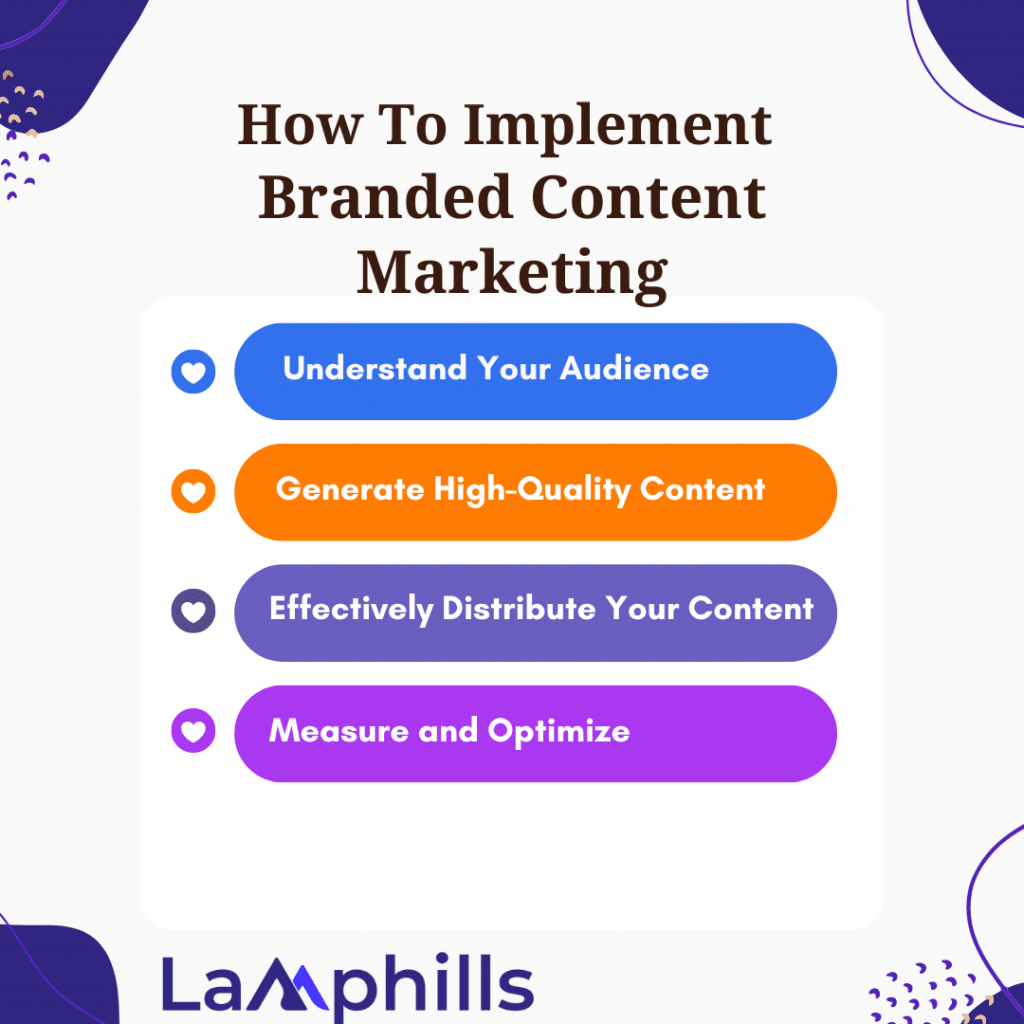I was speaking with a coworker about the most effective marketing methods available today, and we couldn’t help but go into the area of branded content marketing. It’s a strategy that huge brands have perfected, frequently keeping the most effective techniques hidden. So, what exactly is branded content marketing, and why is it such a strong strategy that huge brands are keeping quiet about it? Let’s look at the mysteries of this game-changing method.
What is a Branded Content?
Branded content aims to connect with its audience by focusing on a story rather than a specific product or service. The idea is not to make a direct sale but to generate a debate about a trendy topic or to tell an intriguing tale in an engaging way.
Branded content provides scientific and health leaders with a compelling narrative to communicate their findings and thought leadership. That can include sparking a discussion on a scientific subject, sickness, a research breakthrough, or a new medicinal medicine or device.
One of the evident advantages of this branded content approach is that it deviates significantly from the more usual form of advertising we encounter in our lives.
Branded content can take many different forms, including:
- Blog posts: Brands can write articles or blog entries that provide useful information or amusement about their industry or target audience’s interests.
- Videos: Brands create videos, such as web series, short films, and documentaries, to tell a story or convey a message while quietly promoting their products or services.
- Social media campaigns: Companies use social media campaigns to create and share compelling content on platforms like Instagram and TikTok, which is generally in the form of stories, posts, or challenges.
- Podcasts: Brands can sponsor or produce their own podcasts to explore issues relevant to their business or customer base.
- Events and experiences: Some firms organize real or virtual events, workshops, or experiences to engage with their target audience while quietly marketing their products.
- Infographics and visual content: Sharing informative and visually appealing content, such as infographics, charts, or interactive content, can help a brand effectively deliver its message.
Key Characteristics of Branded Content
To better understand branded content, let’s look at some of its key characteristics:
#1. Focus on the brand’s ideals, not its products or services
Although it can take the form of a traditional video spot, this content focuses on the brand’s intangible attributes rather than the specific things it delivers.
#2. Seeks to build buzz and notoriety for the brand
Rather than seeking a direct sale or conversion, this form of content aims to touch the audience and stimulate debate about the brand. As a result, the major indicators for measuring the success of branded content are typically shares, likes, and mentions.
#3. It creates value for the user
Normally, we think of advertising as a cost to pay to consume the content that truly interests us; however, branded content tries to reverse this notion and generate content that people actually want to consume. Generally, this extra value takes the form of amusement or important knowledge.
#4. It appeals to the emotions
Using emotion to persuade dates back to Aristotle, yet it remains an effective approach today. Branded content may not always strive to utilize intellectual reasoning to justify why a brand is superior to the competition, but instead engages with the viewer on a more personal level.
#5. It employs storytelling
In essence, this form of content aims to tell the audience a tale about the brand, complete with protagonists, beginning, middle, and finish.
#6. It can be provided in a variety of formats and channels
Branded content is a very adaptable concept, thus, it may be used in a variety of formats, including video, podcasts, interactive formats, video games, events, and even a combination of these, to convey the brand’s history. Similarly, there are numerous avenues to distribute this content, including applications, social networks, and the brand’s website.
#7. The content may be co-created
It is usual for brands to work with film directors or other well-known individuals to generate their best content. But the collaborations do not stop there. User-generated content is also a popular resource, as it allows individuals to write their own tales about the company and therefore become involved while contributing content.
What Isn’t Branded Content?
Because the phrase is so new, there is still considerable uncertainty about it. Let’s take a look at the differences between branded content, traditional advertising, content marketing, and product placement.
What are the Benefits of a Branded Content?
Branded content provides various potential benefits to brands, including the following:
- Improved brand awareness: Branded content promotes brand visibility and recognition among a larger audience. Businesses can expand their market presence by generating valuable and shareable content.
- Enhanced brand loyalty: When brands deliver valuable content that is relevant to their audience’s interests and requirements, it can develop a sense of affinity among current customers. Customers are more likely to stay loyal to brands that continuously provide relevant and entertaining content.
- Deeper audience engagement: Branded content can engage audiences at a deeper level than traditional advertising. It can elicit emotional responses, start conversations, and stimulate user-generated content, resulting in more meaningful interactions with customers.
- Increased trust and credibility: By providing informed, honest, and non-invasive content, brands may gain the trust and credibility of their audience. When customers see a brand as a useful source of information or entertainment, they are more inclined to trust and prefer it.
- Educational value: Branded content can be used as an educational resource for customers. By providing relevant information, tutorials, or guides, brands may establish themselves as industry experts and assist customers in making educated decisions.
- Flexibility and creativity: Branded content enables brands to experiment with a variety of content types, including articles, videos, podcasts, and interactive experiences. This flexibility promotes creativity and innovation in marketing efforts.
Why Does Branded Content Marketing Work
Branded content is effective because it uses storytelling to establish an emotional connection with the audience. When individuals have an emotional connection to a brand, they are more inclined to trust it and, eventually, become devoted customers. This strategy emphasizes on developing long-term relationships rather than pushing instant sales.
According to the Content Marketing Institute, 70% of consumers prefer to learn about things through content rather than traditional advertising.
I recall working on a campaign for a client in which we built a mini-documentary series with real-life stories of individuals utilizing their product. Instead of highlighting the product’s characteristics, we focused on how it affected their lives. The response was fantastic. We saw a huge rise in interaction, as well as a surge in customer loyalty to the brand. This event demonstrated the value of storytelling in branded content marketing.
How To Implement Branded Content Marketing

Step #1. Understand Your Audience
- Conduct extensive audience research to better understand their interests, pain issues, and values.
- Use this information to produce content that touches people on an emotional level.
Step #2. Generate High-Quality Content
- Invest in creating high-quality content with an engaging tale. This could take the shape of films, articles, podcasts, or social media updates.
- Use a content production template to ensure that all content is consistent and high-quality.
Step #3. Effectively Distribute Your Content
- Use several avenues to spread your content, such as social media, email newsletters, and collaborations with influencers or other brands.
- To maximize reach, make sure your content is easy to share.
Step #4. Measure and Optimize
- Use analytics to monitor the performance of your branded content.
- Track engagement metrics like shares, comments, and time spent on content.
- Use this data to fine-tune your strategy and improve future content.
Let’s look at some examples of brands who have done a fantastic job developing branded content that you can use as inspiration.
Best Branded Content Examples
#1. Netflix’s ‘Strong Black Lens’
YouTube Series Strong Black Lead (SBL) is a sub-brand of Netflix that highlights and celebrates black voices in TV.
A YouTube series called “Strong Black Lens” in which Black creatives convene at a roundtable to explore all areas of Black storytelling is one of SBL’s most recent kinds of branded content.\

While the purpose is not to promote Netflix shows or TV, some are highlighted if the conversation warrants it.
#2. The HubSpot ‘Culture Happens’ Podcast
We discussed how branded content provides an opportunity to demonstrate your beliefs. Here’s an excellent demonstration of it in action.

“Culture Happens” is a podcast series featuring HubSpot workers that explores the future of work and what it takes to create an inclusive workplace.
What’s fantastic about this series is that stakeholders, consumers, and leads can all benefit from learning more about the narrative HubSpot is creating around its business culture.
#3. The Dove ‘Real Beauty’ Campaign
Dove’s Real Beauty campaign is a striking example of branded content that addresses female empowerment, which is one of the brand’s key beliefs.
In the video, a forensic artist paints a group of women separately. Each woman defines herself, and the artist creates illustrations based on her descriptions.
A stranger then narrates how she perceives the woman, and the artist creates another drawing based on her account.
The women are astounded to see the two sketches, which are completely different from one another. The film emphasizes that women may not always see themselves in a positive light, or in the same manner that a stranger might.
Dove designed this campaign to teach women to love themselves, and its message resonated with its target audience.
#4. Patagonia’s ‘Hasta la Raíz’
Patagonia is a clothing company that promotes environmental action in all forms.
The Hasta La Raíz ad, which translates to “Down to the Root,” depicts the narrative of Javier Zamora, a farmer who worked his way to owning his own organic farm.
The video’s main point is that 97% of farmworkers are Hispanic, but only 4% own farms. Patagonia is collaborating with the Agriculture and Land-Based Training Association (ALBA) to ensure that others may accomplish what Zamora did: demonstrate their dedication to environmental social justice and sustainable farming.
Again, this branded content is not intended to market their products or stimulate sales, but the people in the video are wearing Patagonia apparel while working.
Key Takeaways
- Branded content marketing uses narrative to establish an emotional connection with the audience.
- Branded content is more memorable than regular commercials, resulting in higher engagement.
- By delivering value and telling authentic stories, branded content fosters audience trust.
- This strategy prioritizes long-term connections over short-term sales.
- Proper content distribution is critical for increasing the impact of branded content.
Branded Content Templates for Efficiency
Using a template can help you expedite the content development process, ensuring that each item is of high quality and consistent. Download the template below.
Conclusion
Large brands use branded content marketing as a potent strategy to forge close bonds with their target market, which increases engagement and conversions. By emphasizing storytelling and emotional resonance, you may foster client trust and commitment. Are you ready to start using branded content marketing for your business? What tactics have you found successful in developing compelling content? Share your experiences and let’s learn from one another!
Related Articles
- How to Become a Content Marketing Strategist in Nigeria 2024
- Content Syndication: A Comprehensive Guide
- Content Team: How to Build & Grow an Effective Content Team
- The Essential Content Marketing Analytics Tools and Metrics to Monitor
- What Is Creative Content? All You Need 2024






